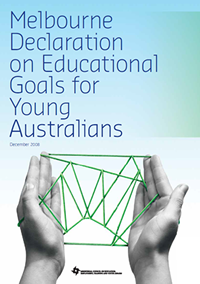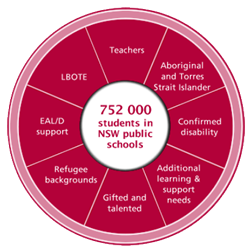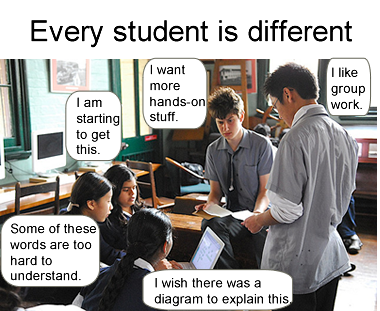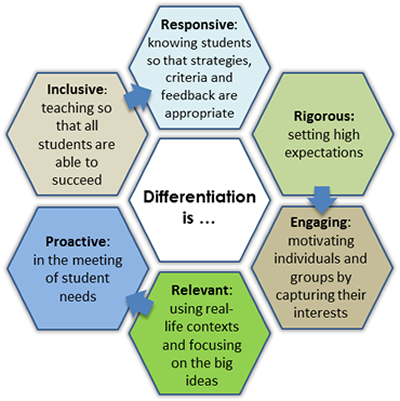Why differentiate learning?

The goals of the 2008 Melbourne Declaration on Educational Goals for Young Australians provide a clear sense of purpose for all Australian schools. They set the direction for schooling for the next 10 years and outline what we intend to achieve and why it is important for our students.
Our collective long-term goal is for every student in every school to experience a sense of success, growth, achievement, well-being and belonging; every student, in every school. To achieve our goal we are going to have to do things differently.
In New South Wales the intent of the Melbourne Declaration is translated through a range of reforms to improve the quality of teaching in schools, to improve outcomes for all students, and to give schools greater authority to meet the needs of their communities, and the NSW BOSTES syllabuses.
The NSW syllabuses describe every student’s curriculum entitlement. Differentiated learning supports all students in being able to access their curriculum entitlement.
|
|
Teachers can access the following policies and strategic action plans to assist in meeting the diverse needs of all learners in their own context: Aboriginal and Torres Strait Islander Education Action Plan 2010-2014 Assisting Students with Learning Difficulties Australian Professional Standards for Teachers Great Teaching, Inspired Learning Local Schools, Local Decisions NSW DEC 5 Year Strategic Plan 2012-2017 NSW DEC Disability Action Plan 2011-2015 Quality teaching in NSW public schools – A classroom practice guide |
Background
There is a wide range of research and theorists whose work supports differentiated learning in the classroom. This course is informed by the work of the following researchers:
|
Researcher |
Article |
|
June Maker |
|
|
John Hattie |
Teachers make a difference – What is the research evidence? (.pdf 548kB) |
|
Carol Ann Tomlinson |
|
|
Michael Fullan |
|
|
Françoys Gagné |
|
|
Frank Williams |
Extract from Support package: Curriculum differentiation – The Williams model (.pdf 2MB) |
|
Stephen Dinham |
What we need to know about student achievement and quality teaching |
Differentiated learning uses June Maker’s model of differentiation as developed and applied by Professor Carol Ann Tomlinson, a leading educator in differentiation. The NSW Quality Teaching model underpins teaching in New South Wales. Tomlinson’s work on differentiation aligns to the NSW Quality Teaching model. It is also clear and concise and can be effectively applied to teaching and learning practice.
Watch the first two minutes of the video Getting started on differentiated learning by Professor Carol Ann Tomlinson.
Diverse learners, diverse needs

Differentiation is central to meeting the diverse needs of all learners.
Teachers become increasingly skilled at identifying individual learning characteristics in order to effectively differentiate learning for all students. Students bring a diverse range of backgrounds and learning experiences to the classroom. Teachers differentiate to cater for the learning needs of every student with the goal of maximising the potential of each learner.
Click on the image on the right to explore facts and figures about student diversity in NSW public schools. Text alternative (.pdf 101kB).
What is differentiated learning?
|
Differentiated learning is a teacher’s proactive response to the needs of the learner. It is driven by the question of “How do I make sure each learner is fully supported to grow as far and as fast as possible in understanding this topic?” Differentiated teaching and learning is based on understanding what students know and can do, what they need to learn next and how best to teach them. Teachers build a profile of each student’s strengths, background and experiences, interests, readiness and learning needs. They use this knowledge to plan teaching strategies, learning experiences and assessments that provide multiple pathways for students to access the curriculum and to demonstrate success. |

|
Definition
In New South Wales teachers are guided by the BOSTES (2012) definition of differentiation:
Differentiation is a targeted process that involves forward planning, programming and instruction. It involves the use of teaching, learning and assessment strategies that are fair and flexible, provide an appropriate level of challenge, and engage students in learning in meaningful ways.
Professor Tomlinson (2004) suggests that a teacher’s skills in differentiation develop over time. Teachers increasingly become more:
-
proficient in understanding their students as individuals
-
comfortable with the meaning and structure of the disciplines they teach
-
expert at teaching flexibly in order to match instruction to student need.
There are misconceptions about differentiation. Read the following to clarify what differentiation is and is not.
|
 |
-
a different lesson for each student each day
-
assigning more work at the same level to students who have demonstrated achievement
-
expecting all students to learn the same content at the same rate and time.
|
|
Activity 1: Differentiation in my teaching practice Reflect on your current practice for differentiation. You will identify strengths and focus areas. Write your response in the Activity booklet available in the Overview tab. |


